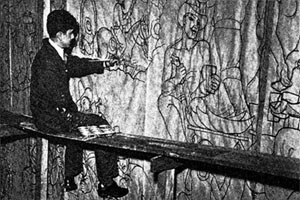Artist: Roberto Cueva del Río
ARTIST PROFILE
Roberto Cueva del Río was born in 1908 in the city of Puebla, Mexico. His family moved to Mexico City when he was a child and there, at age 15, he became an illustrator at the newspaper Excelsior. His newspaper caricatures won him a scholarship to the prestigious San Carlos Academy of Fine Arts in Mexico City, which permitted him to travel through Mexico, exhibit his drawings and caricatures in one-man shows, and paint murals for public schools and private homes. In January 1930, Diego Rivera, then Director of the Academy, gave him an effusive letter of recommendation to support his successful application for support to travel to the United States.
In a May 1931 article in the Mexican newspaper El Universal, José Juan Tablada, an expatriate Mexican poet who met Cueva del Río in New York, describes him as an exceptionally “humble although legitimately ambitious” young man who expresses relief after being offered two important commissions, that he will finally be able to send some money home to his mother.
Cueva del Río portrays Tablada in a caricature dating to 1932, José Juan Tablada and his skyscrapers of cactus and steel. Tablada also tells us that he had recently attended an exhibit of Cueva del Río’s watercolors at Delphic Studios in New York, owned by Alma Reed, former New York Times correspondent and noted patroness of Mexican artists. There he observed a watercolor study for a planned mural on the subject of the Tirada de las Flores, the Festival of the Flowers of Tehuantepec, Mexico. This is likely the same watercolor that appeared on the cover of the September 1, 1933 issue of the magazine Town & Country, which contained a brief article on Cueva del Río’s Embassy murals, including a photograph of the artist at work on the Embassy stairway. This watercolor, with minor modifications, became the model for the popular Festival scene in the Embassy murals.
Cueva del Río began the Embassy murals in 1933, but left them unfinished when he returned to Mexico in 1935 to paint murals in numerous private residences in Mexico City and also, at the invitation of President Lázaro Cárdenas, in various public buildings, including a Gallery of Illustrious Citizens in the State Capitol Building of Michoacan, President Cárdenas’ home state.
When he left Washington in 1935, Cueva del Río signed and dated the murals in the foreground of the “Industrial Mexico” scene (just below the four seated children), the last mural completed before his return to Mexico that year. At that time he also submitted an accounting of his work which provides us with the working titles he used for the various mural scenes and the changes he made in his original plans when he returned to complete the murals in 1941. We learn, for example, that his heroic portrait of Columbus (at the top of the stairway leading to the third floor) was originally planned as a portrait of the Spanish Conquistador Hernán Cortés. Cortés’ historic reputation had fared poorly after the Mexican Revolution, whose ideals emphasized the achievements of the pre-Conquest native civilizations, and Columbus, at the time, may have seemed a less controversial figure.
Cueva del Río returned to Washington to complete the Embassy murals in 1941. In a letter dated August 4, 1941, President Cárdenas thanks him for a photograph of the Embassy murals and congratulates him on his progress.
Cueva del Río’s public murals tend to deal with historical scenes and portraits of heroes. Unlike The Three Great Ones (Rivera, Orozco, and Siquieros), he is not concerned with political ideology and he avoids their scathing attacks on social injustice. Rather, like many contemporary Mexican muralists, he expresses his nationalism by portraying the uniqueness and diversity of Mexican culture, the dignity of ordinary men and women, the beauty of the countryside, the great events and heroes of Mexico’s long history, and the progress of modern Mexico.
NEXT > The Murals


